Crafting Innovative Places for Australia’s Knowledge Economy – a review and application
“We call for rediscovering the role of places in incubating innovation to drive Australia’s knowledge economy.”
Regions across Australia are looking at how to best adapt and thrive to market changes. The challenge is complex and different apply for each region. Part of my work is discovering how to better understand, communicate, and apply approaches to building communities. Thankfully we can all benefit from those who have been focusing on the challenge for some time.
Blakely & Hu’s recent book Crafting Innovative Places for Australia’s Knowledge Economy contributes to a growing body of work that examines how place supports innovation and entrepreneurs. The book provides a detailed perspective specific to the Australian context, with global comparisons and detailed local examples. This post provides an overview of the book, a review of other place-based frameworks, and thoughts on practical applications for building regional capability and capacity.
The local global paradox
Entrepreneurship can happen anywhere. We are in a globally connected world. Any information or service is available with a click of a mouse or touch of a screen. Global collaboration is only a video conference away. We move between regions with ease. Any content you would get in a degree curriculum or accelerator program can be found online.
Yet entrepreneurship is highly localised. In some regions entrepreneurs flourish while in other regions entrepreneurs languish or leave. Governments spend significant public dollars to attract global entrepreneurs to stay within geographic boundaries. Bricks and mortar universities run on-campus programs to convert students into founders. Corporations invest in entrepreneur programs to build local communities and invest in local startups. Private citizens build local innovation hubs and programs to help entrepreneurs build, grow, and scale.
Authors Blakely and Hu describe this dichotomy between easy global access and localised activity as a world that is both “flat and uneven”. Their book Crafting Innovative Places for Australia’s Knowledge Economy begins with a premise that there is now more mobility than ever, yet opportunities are increasingly centralised in geographic locations.
“Successful cities are human capital magnets, attracting people from less competitive and attractive cities and countries.”
The city-based competition for the knowledge economy is ramping up due to the increased pace of globalisation, greater urbanisation from rural to cities, and disruptive innovation. These pressures are felt locally and globally, and each nation and region responds differently. Although rich in resources and opportunity, the authors note that Australia faces challenges from developing resources but not realising the full value of those resources. Australia extracts raw resources and develops knowledge, but both are exported for value creation off-shore which Australians then purchase back as finished goods.
“Mining has been the primary political focus of Australia’s economy, and yet 70 per cent of the nation’s economy received little direct benefit from the mining boom.”
“As Australia exports education, our Asian neighbours benefit from more qualified workforces and increased productivity in manufacturing sectors and innovation. They are then competing with Australia in the global market.”
The solution: urban competitiveness
Many in Australia understand the challenges we face: a historical reliance on resources, an increased pace of globalisation, greater urbanisation from rural to cities, and varying responses to disruptive innovation. Solutions however are a bit more challenging for people to agree on and then apply. Although rich in resources and opportunity, the authors note Australia’s liability and unprecedented growth will not translate naturally into global competitiveness.
“Australia’s advantages in these industrial and construction areas are not being translated strategically into national, and therefore global, competitiveness.”
Blakely and Hu provide an overview of the impact Australia’s lucky country personae and the nation’s global position in relation to innovation factors. A comparison of global innovation places is provided, with an examination of enabling factors in locations including: Silicon Valley, Boston, Shanghai, Singapore, Seoul, Japan, Bangalore, London, Finland, Germany, and Spain. This comparison is then considered at a local level, including innovation precincts in Australian cities of Sydney, Melbourne, Adelaide, and Canberra.
Nations, states, and regions are competing for scarce resources of financial capital, natural resources, and the hearts and minds of the people. Innovation and entrepreneurship is one element of the competition, but integrated with all aspects of a region.
Understanding the landscape – a personal review and application
Much of my work over the past few years has been to understand what we mean by an “ecosystem”. Terms used include innovation ecosystem, business ecosystem, startup ecosystem, cluster, helix, and more.
In 2017 I outlined three models to measure innovation ecosystems. These included: The Kauffman Foundation measures for ecosystem vibrancy (2015); The Entrepreneurial Ecosystem Diagnostic Toolkit from the Aspen Network of Development Entrepreneurs (2013); and The Regional Economic Development Index (2014).
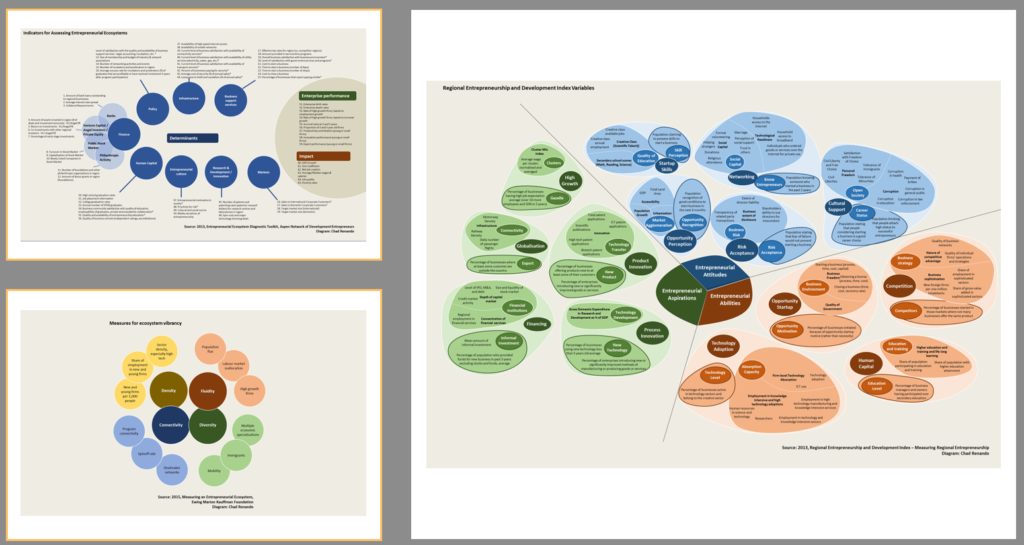
My interest in regional development grew when I managed a local government innovation hub and became increasingly aware that our impact went beyond just economic development. Innovation and entrepreneurship is inherently connected to community development.
This view on non-economic impact is reinforced by Blakely and Hu:
“The importance of incorporating non-economic dimensions into the conceptualisation of, and the methodological approach to, urban competitiveness, such as governance, liveability, social cohesion, and environmental sustainability, is now recognised. A more integrative approach is necessary since the economic, social, and environmental dimensions are interrelated and contribute to a city’s comprehensive competitiveness.”
I explored this further in my post later in 2017 on mapping innovation ecosystems to community resilience. As an experiment, I reviewed how The Regional Economic Development Index indicators mapped to the Queensland Council of Social Service (QCOSS) community resilience profiles (2012). This provided a view on where there is overlap and where there are gaps between economic development community development portfolios.
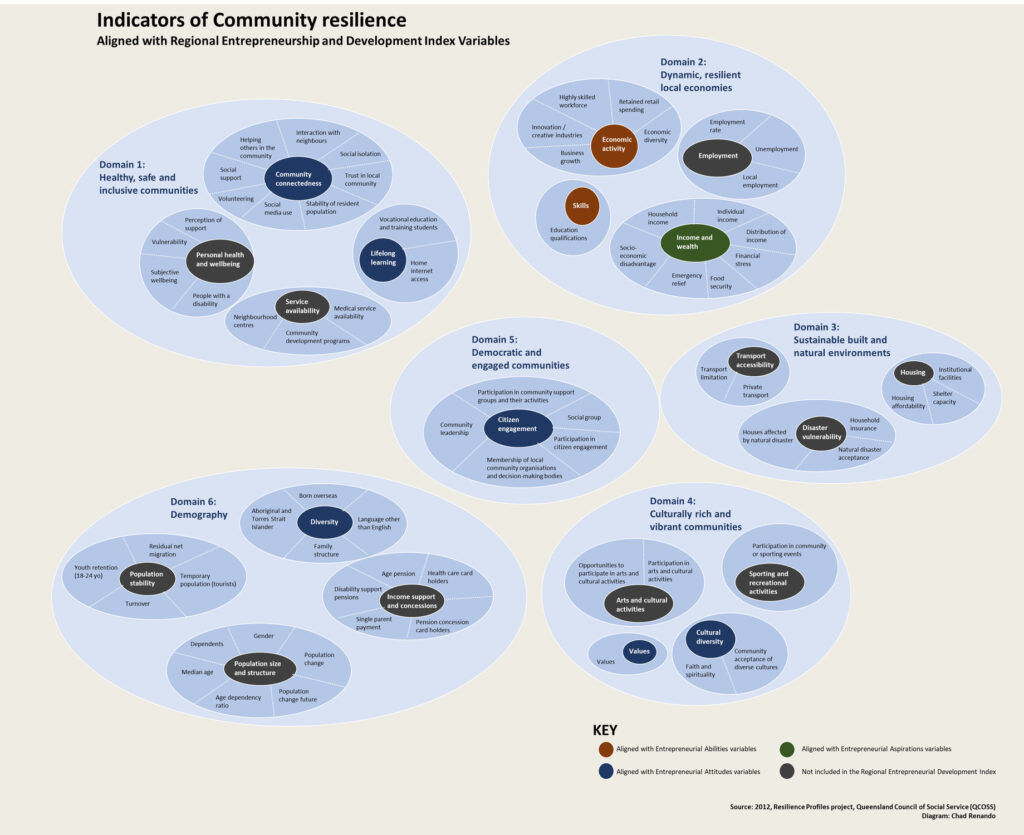
Through 2018, I examined characteristics and differences between regions for innovation development and began to tour Australia to deeply understand common principles that can be applied across different regions.
I am currently applying the frameworks and embedding the principles in a practical measurement and mapping tool that can be used by regional practitioners. A top-level view of the tool can be viewed at your.startupstatus.co/map.
Understanding the landscape – expanding the models
In Crafting Innovative Places for Australia’s Knowledge Economy, the authors reference two other indexes to compare regions. I put the models into infographs to help visualise the dimensions, indicators, and measures for the models to be more easily compared with other models.
The authors compare global cities using the Integrative Urban Competitiveness Index (IUCI). This index contains six dimensions of Governance, Connectivity, Enterprise Hub, Creativity and diversity, Liveability and attractiveness, and Environment and sustainability. Each dimension then has three indicators with specific measures.
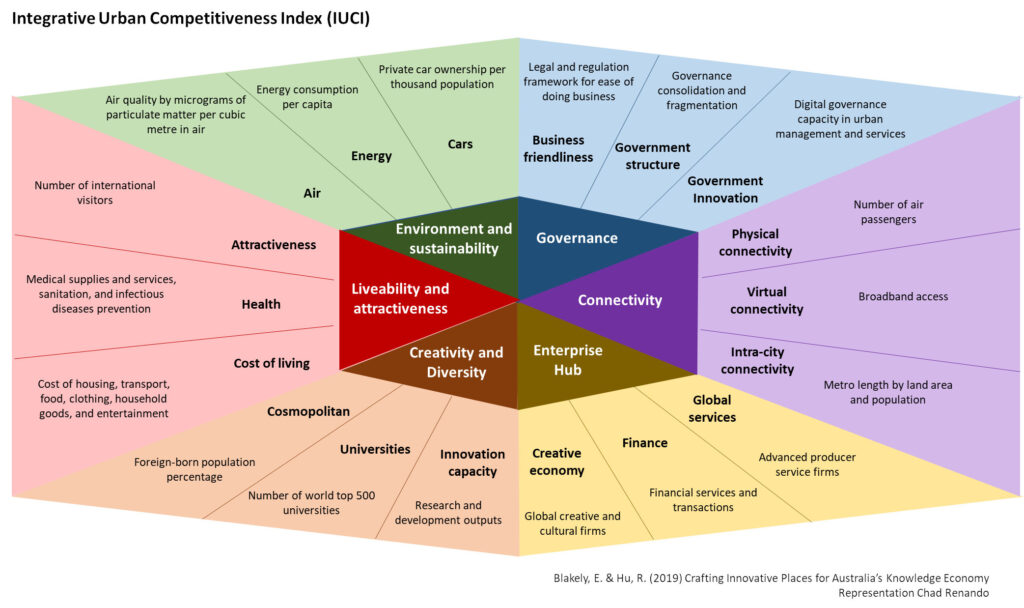
The second model used for Australian metro cities is the Knowledge City Index (KCI). The KCI includes two dimensions of Knowledge economy and Knowledge capital, with three indicators in each dimension.
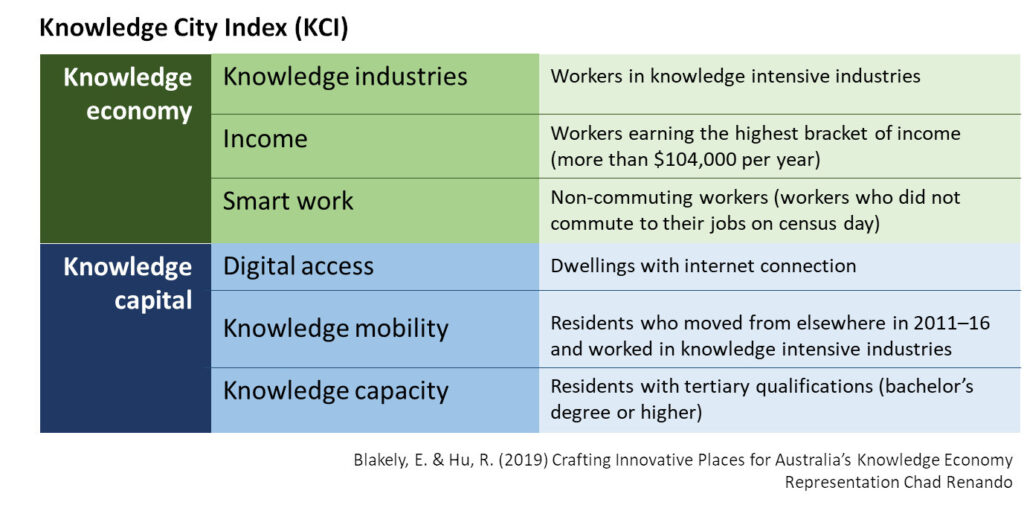
Models such as these are helpful to create a lens by which a region can be assessed. Filling in all the indicators with may not be realistic for smaller regions, but the framework does provide an explanation on areas where regions can compete to improve entrepreneurial and innovation capability and capacity.
If specific tertiary qualifications are important, can university relationships and certain professional pathways be strengthened and encouraged in high schools and later-aged students? If more flexible working arrangements is valued, can dedicated spaces be created or existing work environments be adapted? Can tourism strategies be tailored to attract the knowledge industry and diversity of travelers, a percentage of those who then may decide to stay?
Once we understand which indicators are known to influence the desired outcomes, we can focus efforts at a local level towards making that change.
Define the vision, implement the strategy
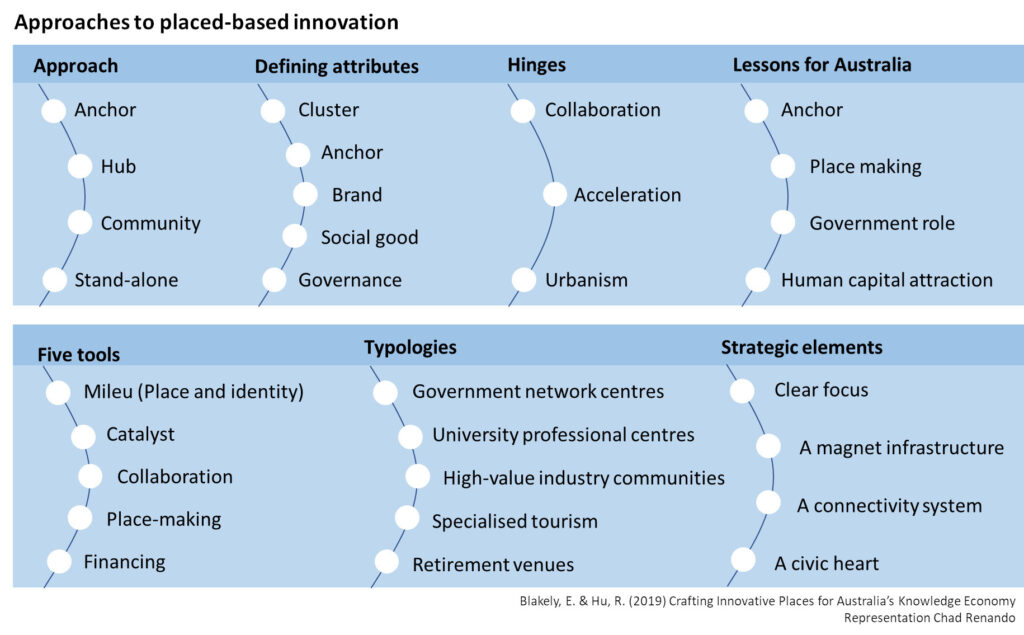
The last half of Blakely & Hu’s book walks you through practical frameworks for building place-based innovation capability, with recent examples of cities where the framework has been applied. A brief summary is not a replacement for the book, but I provide an outline below for reference and to share the basic premise as widely as possible.
Four approaches to innovation region development
There are different approaches a region can take. Is there a single anchor actor, or more of a precinct-type hub of activity? Is it a community-wide, grassroots approach, or a significant, centralised stand-alone effort? Each approach can have pros and cons, and each may have different results depending on the context.
Anchor: Facilities like a university, hospital, research facility, or a large-scale manufacturer or manufacturers with some research base provide an anchor for start-up activities to build on an existing institutional environment.
Hub: An urban environment that is conducive to creativity, characterised by a high density of human capital and soft support services.
Community: Utilise existing schools and community centres, or other neighbourhood facilities such as libraries, as platforms for introducing research and other low-cost knowledge activities. These activities work to teach local residents and improve local skills, while also building a sense of community and participation. This subsequently makes these communities more likely to produce entrepreneurial ventures, while also attracting greater outside investment. This approach is usually coupled with other innovation activities, such as government funding and private venture capital, in the urban or suburban environment.
Stand-alone: Result from intense government investment in money, time, and resources. These types of places require clearly articulated vision and strategy in the design stage, and need to be effectively implemented through strong coordination of actors and resources across several decades.
Five defining attributes of innovation communities
Regardless of the approach, certain attributes exist in innovative communities. There are usually one or more tenants in a community that act as an anchor with a broader cluster. A brand is developed such that a mental picture and emotions are formed when you think about the region and innovation. The outcomes of innovation generally have a localised social outcome, and there is some form of governance structure.
Cluster: Diverse and complementary actors that collaborate, compete, and share so as to further enhance their own and overall innovation capacity and output.
Anchor: Actors such as business entities or educational institutions form the core of innovation districts and act to attract more firms and investors to an area.
Brand: The brand of a place is its identity. Brand has a value, and is an important component of a place’s competitiveness. It informs investors, firms, and talent what the place is about and what it has that may appeal to them.
Social good: The application of disruptive technology and innovative practices that result in social well-being.
Governance: Structure and transparency around decision-making related to the partnerships with the business sector, community participation and engagement, and ongoing governance capacity building.
Three hinges
Innovation systems are different to formal institutions. Rather than being held together by policy and contracts, innovation and entrepreneurial systems have what can be considered as “hinges” that hold relationships together and allow those relationships to flex:
Collaboration: The system of people and firms working in a mutually advantageous manner to define, investigate, research, gain, or refine an understanding or output of an innovative technology, product, or service.
Acceleration: The assembly of soft and hard support services and activities to improve efficiency, and is often provided or orchestrated by governments.
Urbanism: The built environment and the way in which it attracts and encourages innovation.
Four lessons for Australia
So what does this mean for Australia? The authors outline four lessons based on reviewing the approaches and attributes in other global regions:
1. An anchor in some form is important;
2. Place making and design is vital to make certain places innovative and attractive;
3. Governments play a central in the creation and maintenance of innovative places; and
4. Cities must attract and generate sufficient human capital to engage in the global knowledge economy
Five tools to grow innovation capacity
So how is this done? Where should a region start to develop the framework? The authors outline five tools that can be used to build local innovation capability and capacity:
Mileu: Develop a strong sense of place and identity that is conducive to innovation, inclusion, and sustainability.
Catalyst: Define a unique strength of a place that takes the lead in driving innovation.
Collaboration: Foster partnerships of public, private, non-profit, and the community with a focus on collaborative design and creation of innovative places; and develop spaces to facilitate collaborative activities.
Place-making: Apply an innovative planning, design thinking, and approach to make spaces, both private and public, which facilitate and stimulate innovative activities and attract the creative class.
Financing: Develop a flexible financing system, including new channels such as crowdfunding and social financing to support innovators, entrepreneurs, and start-ups.
Five typologies of regional opportunities
The application of a development approach can take many forms, largely defined by the dominant audience and funding source in a region. Certain typologies emerge when looking across a number of regions. A few typologies offered by the authors include:
Government network centres: Government clusters servicing non-metropolitan areas across large regions rather than local communities individually.
University professional centres: University places in non-metropolitan areas at home and globally. The regional universities need to build their reputations and attract academics, so they can become global knowledge nodes and competitive place.
High-value industry communities: Regional communities can be strong competitors in attracting and retaining new, emerging industries because they are away from the congestion and density of cities but have amenities that may appeal to technological industries.
Specialised tourism: build up outsiders’ knowledge about a community’s special qualities, through very concerted, organised, and differentiated information campaigns, so that people will see the place as so unique that it deserves to be experienced and seen, and not visited merely for a rest. Information technology is an enormous help here, as it allows people from around the world to obtain, and then commit to, a consistent vision of the place and the special resources it offers.
Retirement venues: People are leaving their fulltime jobs but they are not stopping working. Retirees like to move to small places, so they can get away from some of the noise of big cities. But they want many attributes of a big city in both how a place treats them and what they can receive from it. Most importantly, they want to be engaged in a place through activities that help build a sense of community and that contribute to the local community’s well-being.
Four strategic elements to build a new economic development strategy in regional areas
Finally, the authors apply the case studies to outline four strategies that apply when building innovation capability and capacity in non-metro areas:
A clear focus: There are many opportunities available for a region. It is important to chose a central theme and consistently communicate that theme to focus and attract attention.
The central focus should become the brand and identity of the community and be supported by a set of activities and communications that undergird this direction. The focus can and should include logos and other communication vehicles to avoid confusion with other places that emphasise similar activities.
A magnet infrastructure: Combining and aligning assets in a region create a strong attraction than individual actors. The opportunity is to be intentional about combining activities to make the most out of individual efforts.
It is not just the importance of having a hospital or clinic or major government facility. It is positioning these assets at the core of the city and combining them with a rich variety of resources that make the place attractive
A connectivity system: Connectivity includes digital, transportation, and face-to-face engagement. Internet connectivity is as vital to business survival as electricity and water is to individual livelihood. A lack of transportation and logistics will cripple a business competing with companies that can be in the same room as a customer or invester in a matter of hours or have their product delivered same-day from a metro-centre. Face-to-face opportunities build relationships that span local boundaries and are essential to information flow.
A civic heart: The connection with place is essential. Beyond pragmatic economic outcomes, there needs to be livability and pride to support the passion.
Strong places have strong identities. These identities are often articulated in combination with a magnet infrastructure— a hospital, a university, or an urban facility known regionally or globally—and are connected both by air and high bandwidth internet communications. These are not things that are just nice to have; they are necessary for any community that wants to grow innovation capacity, develop their identity, and compete globally
Application
This post is not intended to be a prescriptive checklist. The goal is to provide an aid to sense-check current strategy work in regions supporting the place-based systems that help entrepreneurs, and also compare with other methods being applied. This is where I found value, and I capture my notes here in the event others might also benefit.
Blakely & Hu’s Crafting Innovative Places for Australia’s Knowledge Economy is comprehensive. This post is not a replacement for the book, as there are many references that add value for those involved in place-building activities. My intent is to provide a quick reference and a milestone in my ongoing journey to understand, share, and collaborate with those working in similar fields of economic and community development.
As always, your feedback and reflections are welcome.

